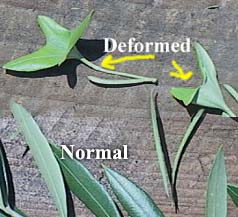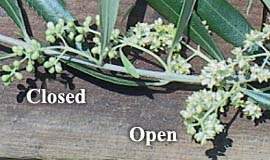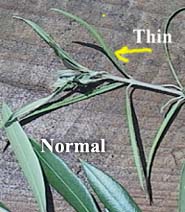Olive trees are a common addition to many of the California landscapes due to the beauty of the tree but more often due to the transplantability of the large specimen. Many developers in the efforts to give a complex a mature look, imported Olive trees from orchards. In some areas, the value of selling a whole tree for transplant is greater than the perceived benefit of harvesting the olives. Some types of fruit trees are in greater demand and farmers will often change tree varieties in an orchard.
While the trees are very attractive, they are also very messy. As most homeowners are not inclined to pick the fruit, the incentive to try to control the mess becomes very important. (Especially if you have white carpets!)
Fruit control is done primarily in two ways.
Acid spray
(2) spray an acid during blossom formation.
 Spray the tree before the blossoms form and the slowing down of the growth causes a short circuit in the trees system and the blossoms don’t form. This technique has one major drawback and that is leaf deformation. The leaves that develop after spraying are thin and don’t provide the surface for photosynthesis that a normal leaf provides. This can and often does lead to tree decline in health. Trees that are routinely sprayed every year can lose vigor and sometimes die.
Spray the tree before the blossoms form and the slowing down of the growth causes a short circuit in the trees system and the blossoms don’t form. This technique has one major drawback and that is leaf deformation. The leaves that develop after spraying are thin and don’t provide the surface for photosynthesis that a normal leaf provides. This can and often does lead to tree decline in health. Trees that are routinely sprayed every year can lose vigor and sometimes die.
The second method used frequently is to time the set of blossoms to when they just open up. An acid based spray will cause these opened blossoms to fall off and not turn into an olive. One big problem with this method is timing. Spray too early and you get poor results. Also the trees generally need two sprays about ten days apart because all blossoms don’t open at the same time. Sometimes there is some yellowing on the foliage due to the acid burn but the damage is minimal. NOTE: Plants under trees are dripped on!
A third approach is to spray the open blossoms vigorously with high pressure water. This can knock off the blooms and decrease the olive population. Frequent sprays are needed to get as many of the blossoms as possible and this procedure only reduces the crop.
 All of these procedures are limited to reducing the crop. A very thorough spray of the growth retardant seems to have the best results but also causes the most damage to the tree. Other trees are also sprayed for fruit reduction such as Liquidambar and Privet. These are limited to the time of blossom development for that variety of tree.
All of these procedures are limited to reducing the crop. A very thorough spray of the growth retardant seems to have the best results but also causes the most damage to the tree. Other trees are also sprayed for fruit reduction such as Liquidambar and Privet. These are limited to the time of blossom development for that variety of tree.
We generally try to discourage the spraying of trees for fruit reduction in most cases. There is so much evidence of damage to olives from the spraying that we try to encourage our clients to learn to deal with the olives if possible. Try the water spray when the blossoms form and the olives you do get will be larger and possibly better for eating! That is a whole different topic but worth looking into. I have eaten some great home canned olives.



 Spray the tree before the blossoms form and the slowing down of the growth causes a short circuit in the trees system and the blossoms don’t form. This technique has one major drawback and that is leaf deformation. The leaves that develop after spraying are thin and don’t provide the surface for photosynthesis that a normal leaf provides. This can and often does lead to tree decline in health. Trees that are routinely sprayed every year can lose vigor and sometimes die.
Spray the tree before the blossoms form and the slowing down of the growth causes a short circuit in the trees system and the blossoms don’t form. This technique has one major drawback and that is leaf deformation. The leaves that develop after spraying are thin and don’t provide the surface for photosynthesis that a normal leaf provides. This can and often does lead to tree decline in health. Trees that are routinely sprayed every year can lose vigor and sometimes die.
 All of these procedures are limited to reducing the crop. A very thorough spray of the growth retardant seems to have the best results but also causes the most damage to the tree. Other trees are also sprayed for fruit reduction such as Liquidambar and Privet. These are limited to the time of blossom development for that variety of tree.
All of these procedures are limited to reducing the crop. A very thorough spray of the growth retardant seems to have the best results but also causes the most damage to the tree. Other trees are also sprayed for fruit reduction such as Liquidambar and Privet. These are limited to the time of blossom development for that variety of tree.